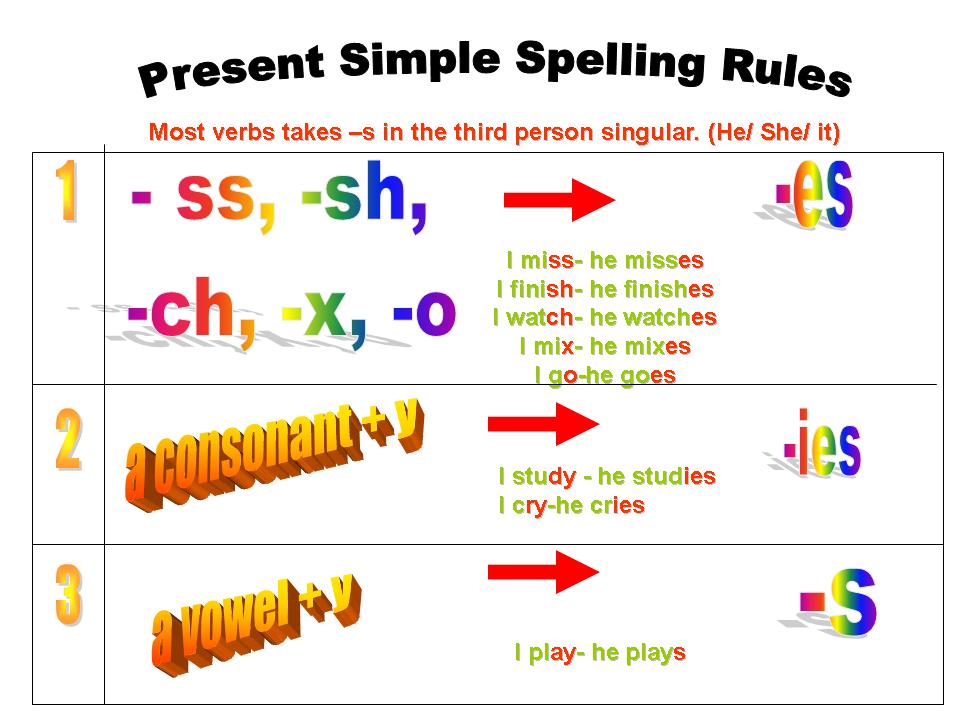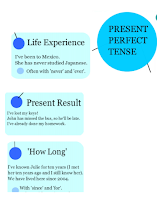Hi there!
These are the notes you must have in your notebook by Thursday.
(estos son los apuntes en azul, que tenéis que copiar en inglés en el cuaderno de aquí al viernes. Cuando pone una traducción en negro, si estáis seguros de lo que significa, no hace falta copiarlo en español, pero tenéis que saber bien qué pone en los apuntes)
Present Simple vs Present Continuous
The present simple only uses one word (palabra)
in the affirmative
The present continuous uses 2 words (palabras)
, one is an ing form (una es una forma en ing)
Example:
A. Present Simple
1. Special verbs (that use no auxiliary)
2. Most verbs (that use auxiliary)
3. Spelling cases: third person singular S
4. Use and signal words
1. Special verbs (that use no auxiliary)
There are some verbs that don't use an auxiliary (do, does, don't, doesn't) to make the negative and interrogative.
(hay algunos verbos que no usan un auxiliar (do, does, don't, doesn't) para hacer ni la negativa ni la interrogativa).
Don't write do with these verbs when writing the negative or interogative
(no escribáis el auxiliar do con estos verbos para hacer su negativa o interrogativa)
Be - ser , estar
Can- poder, saber hacer
Have got- tener only in British English.
See photocopy (ver fotocopia, os daré estos verbos fotocopiados)
2. Most verbs (that use auxiliary)
Most verbs use do to make the negative and interrogative form
(la mayoría de los verbos, que si usan auxiliar do, does, don't o doesn't para hacer la negativa o la interrogativa)
Copy this example:
(recordad copiar la columna de afirmativa, la de negativa sólo la que pone contractions, interrogativa y short answers affirmative and negative)
3. Spelling cases: third person singular S
Most verbs add an "s" in the affirmative with the pronouns: HE, SHE, IT
(la mayoría de los verbos añaden una S en la afirmativa con los pronombres He, she, it)
But there are some cases where we put: (pero en algunos casos ponemos )
Copy this image and the examples (copiad esta imagen con los ejemplos)
Practise here
4. Use and signal words
There are many uses for the Present Simple, but we are mainly going to concentrate on two of them.
(Hay muchos usos del present simple, pero nos vamos a concentrar principalmente en dos de ellos).
Routines & Habits
General Truths &facts
(rutinas y hábitos--- verdades generales y hechos)
Example of routine and habit: Iván usually plays football at school.
Example of general truth: Madrid is the capital of Spain
Signal words:
Copiad el significado de lo que no sepáis
Always (siempre)
Often (a menudo)
Sometimes (a veces)
Seldom (raramente)
Never (nunca)
Every day (cada día/ todos los días)
Every week (cada semana /todas las semanas)
Every year (cada año/todos los años)
O cualquier expresión de tiempo que vaya con Every
On Mondays (los lunes) Ojo, pone on MOndays, así que es todos los lunes
after school: después del colegio.
End of notes to be copied in notebook --- Fin de los apuntes a copiar en el cuaderno
This week we are going to go through the
PRESENT
Simple, continuous and perfect
Look at this picture:
When do we
use each?
Games to practise:
Only present simple
Prezi presentation
Important verbs (be, have got, can) (no auxiliary)
Rest of verbs (affimative, negative ad interrogative) Using and auxiliary
Spelling cases(adding the third person "S" go-goes, catch-catches....)
Use and Signal words
Interactive monkey
Adding the third person s
Only present continuous
Para familiarizarse con la estructura:
Very easy (muy fácil)
(No os entretengáis mucho en este)
When do we put
am, are or is: ? (Also very easy)
Adding ing form (añadiendo el ing)
Present simple and present continuous
You must know when to use one and the other
How fast can you think sentences (easy)
Snake and ladders (this one is good to practise)









